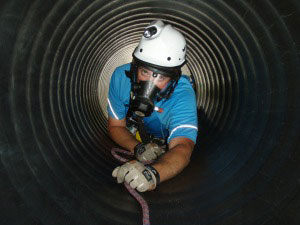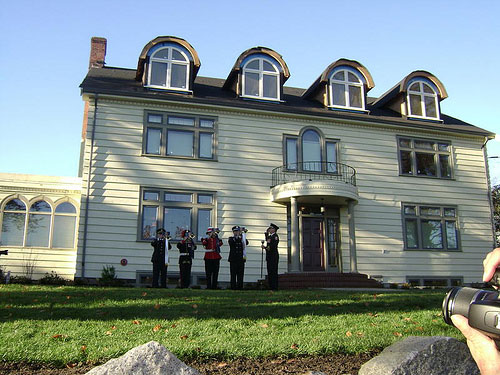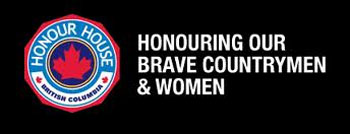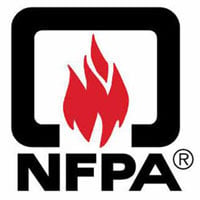How do you rescue a man stuck in grain to just above his waist? Very carefully — and slowly — said Corpus Christi, Texas, firefighters who built a special wooden box that enclosed the trapped man. They were then able to lower the grain level around the worker enough to pull him to safety, hours after he became stuck in a grain elevator. Thirty firefighters, rotating in teams, spent about five hours in the delicate rescue effort at the Corpus Christi Grain Co., said Assistant Fire Chief Randy Paige.
 CNN reported this dramatic grain rescue by the Corpus Christi Fire Department back in April. OSHA has just announced significant penalties and multiple violations for theTexas grain company. Here’s more…
CNN reported this dramatic grain rescue by the Corpus Christi Fire Department back in April. OSHA has just announced significant penalties and multiple violations for theTexas grain company. Here’s more…
How do you rescue a man stuck in grain to just above his waist? Very carefully — and slowly — said Corpus Christi, Texas, firefighters who built a special wooden box that enclosed the trapped man. They were then able to lower the grain level around the worker enough to pull him to safety, hours after he became stuck in a grain elevator. Thirty firefighters, rotating in teams, spent about five hours in the delicate rescue effort at the Corpus Christi Grain Co., said Assistant Fire Chief Randy Paige.
The 50-year-old unidentified man was alone inside the grain elevator when he became stuck, said Paige, who did not know what the employee was doing inside or what variety of grain was in the structure. The man was discovered more than an hour later by co-workers, and the rescue began, with a successful conclusion around 8:30 p.m. The man was taken Wednesday night to a local hospital for observation and was in stable condition, Paige told CNN. The man did not complain of injuries.
Firefighters who arrived on the scene opened a hatch on the side of the round elevator, which is about 100 feet in diameter and about 75 feet tall, officials said. They could see the employee who was a few feet above ground level in the tank. He also was standing above valves that release grain to an area below ground, Paige said. As they got to work, they also saw that the grain rose in a “V” shape along the tank’s walls to about 50 feet above the worker, who was in the middle of the elevator, Paige said.
“This stuff is real fine and granular and he was unable to move,” the chief said. Crews used plywood to build wood shoring that was about the shape of a small closet. They put it in position around the employee. When they opened the valve, the grain dropped and they were able to pluck the employee to safety. “We had to be very careful and slow at this,” said Paige. “We were worried about an avalanche effect.”
The fire official was proud of his team, which had three members inside the tank at all times. They had to deal with warm temperatures and were able to get fluids, by water and intravenously, to the trapped man. “Luckily, the dust was not too bad.” It all came down to training and resourcefulness, Paige said.
 What were the other options? Plan B called for using a hoisting device at the top of the elevator, but crews were worried about the stress on the employee’s body if they tried to pull him up. Plan C involved a vacuum truck that would have removed the grain.”Luckily, Plan A worked on this one,” said Paige.
What were the other options? Plan B called for using a hoisting device at the top of the elevator, but crews were worried about the stress on the employee’s body if they tried to pull him up. Plan C involved a vacuum truck that would have removed the grain.”Luckily, Plan A worked on this one,” said Paige.
OSHA has cited Corpus Christi Grain Co. in Corpus Christi, Texas, for six willful and 20 serious violations with total proposed penalties of $258,900. OSHA‘s Corpus Christi Area Office initiated its inspection at the company’s facility after it was reported that a worker was engulfed while emptying grain from a storage bin. The employee was rescued due to the exceptional efforts of the Corpus Christi Fire Department.
“Employees working in grain storage buildings are exposed to dangerous conditions, and proper safety measures must be taken,” said Michael Rivera, director of OSHA’sCorpus Christi office. “If OSHA’s standards were followed, it is possible this unfortunate incident could have been avoided.”
The willful violations include failing to provide personal protective equipment, such as a body harness and life line, for employees working with stored grain; perform lockout/tagout procedures for the energy sources of equipment, such as augers and conveyors, while workers are inside the grain bins; and have a competent attendant present with rescue equipment when workers enter grain storage bins.
The serious violations include failing to ensure that employees are trained on the hazards associated with grain handling, cover openings with grates in grain bins, ensure that workroom floors are clear of combustible dust, and provide a preventive maintenance schedule for machinery.

OSHA


 “I have attended other Technical Rescue training programs, and the instruction and training that I have received during this FAST TRACK 120 course has been within the top 3 courses I’ve attended in my 20 years in the Fire Service.” ~ Jason Kuni Diorec, Emergency Response Assistant Chief, ConocoPhillips Alaska, Inc.During a recent FastTrack 120 class in Baton Rouge, we had the opportunity to talk with one of our students who traveled all the way from Alaska.
“I have attended other Technical Rescue training programs, and the instruction and training that I have received during this FAST TRACK 120 course has been within the top 3 courses I’ve attended in my 20 years in the Fire Service.” ~ Jason Kuni Diorec, Emergency Response Assistant Chief, ConocoPhillips Alaska, Inc.During a recent FastTrack 120 class in Baton Rouge, we had the opportunity to talk with one of our students who traveled all the way from Alaska. A: We are a unique industrial facility due to our remote location on the Alaska North Slope. We are isolated from any emergency response services for miles, so we supplyour own emergency response services to protect life and property in the Boundaries of ConocoPhillips leased land.
A: We are a unique industrial facility due to our remote location on the Alaska North Slope. We are isolated from any emergency response services for miles, so we supplyour own emergency response services to protect life and property in the Boundaries of ConocoPhillips leased land.


 We recently read an article from the NFPA Journal about the improvements that have been made since 9/11. Out of this tragedy came some very hard lessons learned – from an emergency response standpoint as well as national security and building codes, especially for high-rise structures. Are we better prepared? Is your department better equipped today for acts of terrorism or natural disaster? Has communications improved among responding agencies? Are you better trained as an emergency responder? An article in the September/October 2011 issue of the NFPA Journal cites three main areas that have improved as a direct result of the 9/11 terrorist attacks.
We recently read an article from the NFPA Journal about the improvements that have been made since 9/11. Out of this tragedy came some very hard lessons learned – from an emergency response standpoint as well as national security and building codes, especially for high-rise structures. Are we better prepared? Is your department better equipped today for acts of terrorism or natural disaster? Has communications improved among responding agencies? Are you better trained as an emergency responder? An article in the September/October 2011 issue of the NFPA Journal cites three main areas that have improved as a direct result of the 9/11 terrorist attacks.


